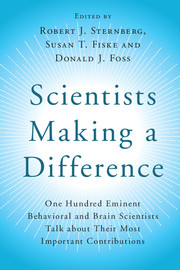 Scientists Making a Difference
Scientists Making a Difference from Section A - Feelings, Fears, Stressors, and Coping
Published online by Cambridge University Press: 05 August 2016
Writing about one's work is embarrassing, but the editors of this book have made the assignment easier by providing the authors with guiding questions. I will address them in the original order, as if I were answering questions in an imaginary interview.
What Do You Consider to Be Your Most Important Scientific Contribution?
I believe my best contribution has been the attempt to elucidate the nature of affective phenomena, in particular the collection of processes known as feelings and emotions. I have tried to understand these phenomena in psychological as well as neural terms, by placing them in the context of their likely evolutionary origin, immediate functional consequences, and ultimate implications.
Part of my contribution has to do with achieving some clarity regarding the definition of these phenomena, an indispensable part of scientific progress. This has not been easy because problematic definitions have hampered affect research beginning with William James, the genius creator of the field. For example, feelings and emotions are often thought to be one and the same thing, by specialists and by lay public alike, but they clearly are not.
Feelings are mental accounts of the state of life within the organism in whose mind the feeling occurs. In other words, feelings are mental portrayals of the myriad actions required to perform life's management as it proceeds, moment by moment, within an organism. The range of “portrayed” actions includes the contraction or distention of muscle fibers required for visceral functions (cardiac, respiratory, digestive), as well as the release of endocrine and neuromodulator molecules. Thus, the language used in the portrayal is not that of the external senses – such as vision or audition – but rather the language of internal sensation, also known as interoception.
The regulatory operations that we experience as feelings can be quite simple or fairly complex. Examples of the former include the physical states of hunger, thirst, pain, and pleasure. The corresponding feelings are called homeostatic. Examples of the latter – the complex regulatory operations – include emotive reactions such as panic, desire, caring and compassion, joy, fear, and anger. The corresponding feelings are called emotional. The action programs of such emotions are engaged either by internal drives and motivations or by certain external conditions.
To save this book to your Kindle, first ensure [email protected] is added to your Approved Personal Document E-mail List under your Personal Document Settings on the Manage Your Content and Devices page of your Amazon account. Then enter the ‘name’ part of your Kindle email address below. Find out more about saving to your Kindle.
Note you can select to save to either the @free.kindle.com or @kindle.com variations. ‘@free.kindle.com’ emails are free but can only be saved to your device when it is connected to wi-fi. ‘@kindle.com’ emails can be delivered even when you are not connected to wi-fi, but note that service fees apply.
Find out more about the Kindle Personal Document Service.
To save content items to your account, please confirm that you agree to abide by our usage policies. If this is the first time you use this feature, you will be asked to authorise Cambridge Core to connect with your account. Find out more about saving content to Dropbox.
To save content items to your account, please confirm that you agree to abide by our usage policies. If this is the first time you use this feature, you will be asked to authorise Cambridge Core to connect with your account. Find out more about saving content to Google Drive.